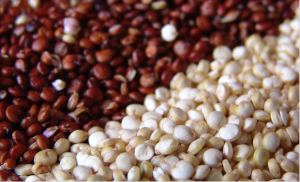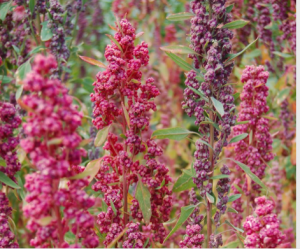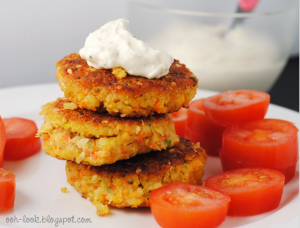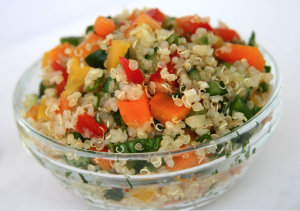By Catharine L. Kaufman (a.k.a. The Kitchen Shrink)
It’s a seed! It’s a protein! It’s SUPERFOOD!
 Imagine unpacking and listing the nutritional contents of a plant consisting of edible leaves and clusters of seeds commonly mistaken for grain—and finding that the latter contains practically the entire gamut of food components needed to keep a human being well nourished. In addition to its carbohydrate starches and abundant protein composed of a balanced set of essential amino acids, quinoa (pronounced keenwa) also packs a treasure-trove of dietary fiber, thiamine (vit. B1), riboflavin (vit. B2), vitamin B6, folate (vit. B9), iron, magnesium, phosphorus, zinc, calcium and more. What’s more, it is gluten-free and easy to digest.
Imagine unpacking and listing the nutritional contents of a plant consisting of edible leaves and clusters of seeds commonly mistaken for grain—and finding that the latter contains practically the entire gamut of food components needed to keep a human being well nourished. In addition to its carbohydrate starches and abundant protein composed of a balanced set of essential amino acids, quinoa (pronounced keenwa) also packs a treasure-trove of dietary fiber, thiamine (vit. B1), riboflavin (vit. B2), vitamin B6, folate (vit. B9), iron, magnesium, phosphorus, zinc, calcium and more. What’s more, it is gluten-free and easy to digest.
No wonder quinoa is being considered by NASA’s Controlled Ecological Life Support System as the crop to take along on future space explorations of long durations, flown by humans.
Origins: Pre-Columbian Andean hunter-gatherers who lived in the region now occupied by Columbia, Ecuador, Bolivia and Peru, must have been aware of the plant’s versatility and life-sustaining power, for quinoa became a mainstay of their diet. Archeological finds dated the use of wild quinoa back about 5,200-7,000 years—although domesticated strains only appeared some 3-4,000 years ago.
When the Incas declared quinoa sacred and included it in religious rituals—expanding its value as a food source to social and spiritual importance—the plant’s fate was sealed, at least for the duration of Spanish conquest and colonization, when the cultivation of this ‘non-Christian’ crop was banned and the  region’s indigent population was forced to grow wheat and later maize (corn) instead of quinoa.
region’s indigent population was forced to grow wheat and later maize (corn) instead of quinoa.
Although quinoa never regained its dominant place in the region’s agriculture—and even when it did make a comeback, of the more than 120 species once known to Andean civilizations, only three went back into contemporary cultivation. Most popular of the three strains—because of its similarity in flavor and consistency to rice—is the cream-colored quinoa seed, which is sold in supermarkets everywhere. The red and more rare black varieties can be found mostly in specialty food stores.
Since this clever plant protects its precious seeds from birds and bugs with a coating of bitter-tasting saponins, it requires no chemical protection while under cultivation—although it does require some processing after it is harvested, to eliminate the saponins. Most quinoa sold in North America has been processed to remove its bitter coating, saving consumers the bother to do it themselves.
Hot, Cold, Savory, Sweet—Anything Goes in Quinoa Preparation: Liberate your culinary creativity and find as many uses for this versatile and nutritious delicacy as your imagination allows.  Cook up a batch in water (see package instructions) or toast at low heat on stovetop with olive oil for a nutty taste (adding chopped onion and/or garlic for a super pilaf). Either way, you’ll notice a tiny, thread-thin ‘tail’ curling away from each crunchy seed, but combining in the mouth for a delightful flavor—which makes some people think of miniature rice grains.
Cook up a batch in water (see package instructions) or toast at low heat on stovetop with olive oil for a nutty taste (adding chopped onion and/or garlic for a super pilaf). Either way, you’ll notice a tiny, thread-thin ‘tail’ curling away from each crunchy seed, but combining in the mouth for a delightful flavor—which makes some people think of miniature rice grains.
Be daring—quinoa may look delicate, but it keeps its texture and look when cooked. Use confidently in salads. Serve as a side dish with stews or stir-fries. Combine with ground meat for turkey burgers or meatloaves—or pair with legumes and veggies for vegetarian/vegan burgers. Get fancy by tracking down all three quinoa strains—cream colored, red and black—and create a tri-color hot or cold dish for your dinner guests. Boil quinoa in apple or orange juice and add fresh or dried fruit and cinnamon for a just-sweet-enough breakfast cereal or desert ‘pudding.’ Whip up muffins, breads, cookies, scones or pancakes with quinoa flour. Or do all or any of the above when quinoa-lust strikes. You may even go raw by sprouting the quinoa seeds and topping your sandwiches with the green shoots. Nor should you pass up the quinoa plant’s nutrient-rich green leaves, which can be tossed with salad greens, steamed like spinach or sautéed with olive oil and garlic.
The following divine Tabouli Quinoa Salad recipe, recently added to the menu of San Diego’s Sammy’s Woodfired Pizza restaurant, was generously  shared with me by its creator, Executive Chef Jeff Moogk:
shared with me by its creator, Executive Chef Jeff Moogk:
Tabouli Quinoa Salad
½ cup of shredded carrot
2 cups chopped parsley
1 cup chopped mint
1 cup diced onion
1 cup diced fresh tomato
1 cup diced cucumber
2 cups shredded lettuce
1 cup cooked quinoa
½ cup extra virgin olive oil
½ cup fresh-squeezed lemon juice
2 tsp salt (optional)
2 tsp ground black pepper
1 tsp ground allspice
Cook quinoa according to package directions—and cool. Combine all ingredients and mix well. Serve over a bed of Romaine leaves. Serves 6—8 persons at lunch or dinner.

